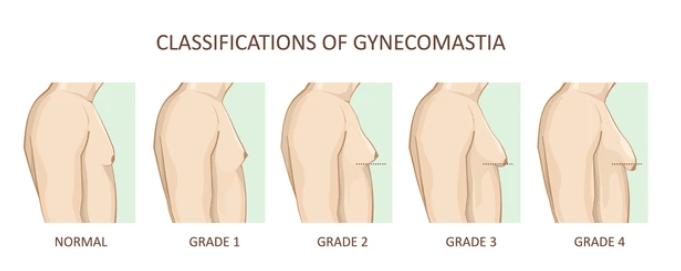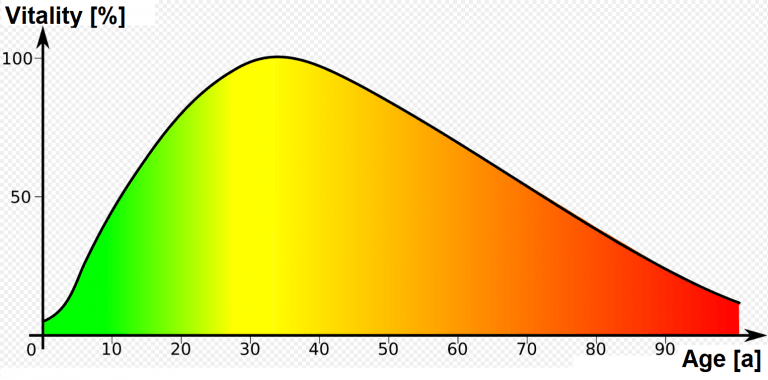Varicocele Gynecomastia (Gyno)
Learn more about Varicocele Gynecomastia on this page.
- Is the formation of gynecomastia (Gyno) possible due to varicocele?
- These are the types of gynecomastia
- These are the main causes of gynecomastia
Varicocele Gyno (Gynecomastia)
Can a Varicocele cause Gynecomastia?
The development of female breast growth in men is called gynecomastia (Gyno). During the development of gynecomastia, the male glandular tissue, among other things, grows. Since the breast tissue reacts very sensitively to fluctuations in the hormone balance, unnatural fluctuations can lead to unwanted breast growth. A distinction is made primarily between pubertal gynecomastia (gynecomastia during puberty) or gynecomastia in adulthood. The cause of fluctuations in adulthood is often the use of medications that disrupt the hormonal programming of the body. However, age and the associated decrease in testosterone levels in the body can also be the cause of gynecomastia. Depending on which form of gynecomastia is present, different treatment methods are suggested.
The different forms of gynecomastia are differentiated based on their causes:
physiological = normal, natural growth
pseudo gynecomastia = fat storage in the breast tissue
pathological = abnormal growth
Gynecomastia due to varicocele
1. natural (physiological) gynecomastia:
Physiological gynecomastia carries its causes in fluctuations of the hormonal balance and often regulates itself again.
Newborn gynecomastia: Newborn gynecomastia is caused by the mother’s female hormones. These are transferred to the newborn baby through the placenta. Newborn gynecomastia usually resolves on its own.
Pubertal gynecomastia: Pubertal gynecomastia develops in about half of male adolescents during puberty and usually (not always) regresses completely. For a long time, the cause of pubertal gynecomastia was thought to be breast growth due to increased estrogen. The consequence of the increased estrogen in the body was therefore a shift in the estrogen-testosterone balance, which caused breast growth. However, Danish scientists refuted this assumption and found that pubertal gynecomastia must most likely be related to a highly elevated insulin-like growth factor 1 (IGF-1).
Senile gynecomastia: Senile gynecomastia is thought to be caused by the increasing mass of adipose tissue with age compared to the overall decreasing body mass. As a result, the body produces more estrogen overall. At the same time, male testosterone production decreases with age (see graph). In the case of geriatric gynecomastia, it is therefore fair to say that breast growth is caused by increased estrogen and decreased testosterone levels.

2 . Pseudogynecomastia (Pseudogyno)
A further distinction is made between pseudogynecomastia, which describes fat storage in the breast tissue. The most common cause of this is obesity. Pseudogynecomastia is also referred to in cases of general obesity (adiposity). The transition from overweight to obesity is reached at a body mass index (BMI) of about 30.
3. Pathological gynecomastia
Genuine gynecomastia is not a disease in itself, but a symptom. Thus, various hormonal disorders or diseases, growth hormone abuse, castration or side effects of medications can lead to breast enlargement. Examples of causes of true gynecomastia are:
Deficiency of male sex hormone, such as testosterone (hypogonadism).
Increased estrogen production, for example as a result of hormone therapy (bodybuilding)
Chronic diseases (alcohol abuse as cause / organ failure as a consequence: kidney failure, liver failure)
Medications: “In addition to hormones, the most common triggers include acid blockers such as cimetidine, ranitidine and omeprazole, the aldosterone antagonist spironolactone, the prostate drug finasteride, cardiac glycosides such as digoxin and calcium antagonists of the nifedipine and verapamil type, and neuroleptics of the phenothiazine type or sulpiride.”
4. Gynecoamstia due to varicocele – No!
By definition, a varicocele describes disturbed blood circulation in the venous plexus in the spermatic cord (pampiniform plexus) formed by the testicles and epididymis. The partially blocked blood circulation at the testis means a higher overall pollutant load on the testicles. These pollutants, as you learned on the varicocele pain page, can cause long-term damage to the affected testicle. As a result of the overheating and pollutants, the affected testicle can no longer perform at 100% of its original capacity, negatively affecting testosterone release. A too low testosterone level in combination with a too high estrogen level can indeed cause the formation of female breast tissue (Gyno). Nevertheless, it is rather unlikely that varicocele alone will cause the formation of female breast tissue. Read more.
Can a Varicocele cause Gynecomastia?
Accumulation of blood (with harmful substances) in the varicocele
Damage to the testicles and veins
Damaged testicles cause hormone imbalances
Hormone imbalance can trigger gynecomastia.
However, varicocele alone is NOT the trigger!
The main causes of gynecomastia
Known causes of true gynecomastia are in most cases due to a disturbance of hormonal balance. The following causes are distinguished:
- Increased responsiveness of the male breast tissue to the female sex hormones (estrogens)
- An increased concentration of estrogens in the male blood. This can be caused, for example, by hormone therapy in the treatment of prostate carcinoma. An estrogen-producing testicular tumor or diseases of the pituitary gland / hypothalamus may also be responsible. Increased estrogen secretions may also occur during puberty (see pubertal gynecomastia)
- A reduced concentration of testosterone in the male blood. This can be caused, for example, by an underactive gonad, geriatric gynecomastia (see above) or reduced testosterone formation in the testicles in the case of paralell excess estrogen.
- Independent causes such as thyroid disorders, cirrhosis of the liver or dialysis for kidney failure (renal insufficiency)
- The intake of high hormone concentrations through food, for example hormone-treated meat.
- The administration/injection of testosterone, for example medically indicated or as a growth booster in bodybuilding. As a result of testosterone substitution, this can be partially converted into female hormones (estrogens) in fat and muscle tissue by the enzyme “aromatase”.
- It can be concluded that a varicocele alone is not the cause of the development of gynecomastia. It is more likely that a varicocele occurs in combination with one of the causes listed above. For example, the cause in combination with a varicocele may be obesity, an unhealthy lifestyle (diet, too little sport/exercise, high coffee consumption, too little sleep, smoking, alcohol, testosterone substitution, etc.).

So what to do to prevent varicocele gynecomastia?
In fact, there are quite a lot of factors in personal lifestyle with which you can raise the testosterone level in the body naturally. Here are some treatment suggestions to increase the testosterone level in the body naturally:
1. Lifestyle Adjustment:
Lose body weight: Less fat in the body will lead to higher testosterone levels
Exercise more: It is scientifically proven that active men have higher overall testosterone levels than inactive ones
Adjust diet: Eat a healthy and balanced diet of mostly unprocessed foods
Stop smoking cigarettes and drinking alcohol: Also scientifically proven that these habits lower testosterone levels in the body
…
Learn more about varicocele testosterone here.
2. improving testicular health: achieving a healthy testicular temperature throughout the day.
Did you know that a 1° Celsius increase in testicular temperature can lead to a whole 40% decrease in testosterone levels? So ALWAYS ensure adequate testicular temperature through daily routines. For more information, see the guide to varicocele treatment.
Get breathable and supportive (not compressive!) underwear. More information on well-suited underwear and good reasons why most styles are better not worn can be found in Chapter 10 of the guidebook and here on the website under Varicocele Clothing.
Another solution to achieve an adequate testicular temperature on a daily average lies in the treatment by different cooling methods. Cooling causes the swollen veins to contract, restoring healthy blood flow to the scrotum and increasing testosterone production. For overheating, pain, and normalization of testicular temperature, read the details in Chapters 5, 6, and 10.
How to prevent varicoceles gynecomastia?
Risk-free treatment measures for
Restoration of healthy blood circulation
Stimulation of healing and support in regeneration.
Natural measures to establish a healthy testicular temperature
Prevent further damage to veins and testicles
Restoring overall testicular health
Increase the natural level of testosterone in the body.
Prevent formation of varicoceles gyno.
Read now the complete guide to the natural treatment of varicocele. Get complete knowledge about the different natural treatment methods and then start with the natural treatment at home risk-free. Achieve freedom from pain in just a few days and enjoy numerous other positive results.
Studies and sources:
- COPENHAGEN Puberty Study → Mikkel G. Mieritz, Lars Lau Rakêt, Casper P. Hage u. a.: A longitudinal study of growth, sex steroids and insulin-like growtht factor I in boys with physiological gynaecomastia. In: The Journal of Clinical Endocrinology & Metabolism. (J Clin Endocrinol Metab.) veröffentlicht online 19. August 2015, doi:10.1210/jc.2015-2836 (Volltext als PDF-Datei).
- Hans-Peter Kuhne, Sandy Egler, Stefan Lenz u. a.: GMS Interdisciplinary Plastic and Reconstructive Surgery DGPW 2012/ Gynecomastia in German soldiers: etiology and pathology. Auf: egms.de ; zuletzt abgerufen am 5. Mai 2016. 2012.
- B. Neu, V. Sautter, M.-L. Sautter-Bihl: Radiotherapy for prophylaxis and therapy of antiandrogen-induced gynecomastia in prostate carcinoma. Magdeburg 2010 (Full text as PDF file; 640 kB (Memento of the original on 21 February 2014 in the Internet Archive) i Info: The archive link was inserted automatically and has not yet been checked. Please check the link according to the instructions and then remove this note).
- Lipomatoses. In: Medical dictionary. m-press münchen gmbh (Memento of January 10, 2007 in the Internet Archive).
- Reduce swelling
- Improve fertility
- Prevent further development
- Restore hormone balance
- Achieve freedom from pain and symptoms
